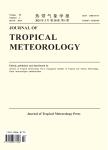A COMPARATIVE STUDY ON CHARACTERISTICS AND THERMODYNAMIC DEVELOPMENT MECHANISMS OF TWO TYPES OF WARMSECTOR HEAVY RAINFALL ALONG THE SOUTH CHINA COAST
A COMPARATIVE STUDY ON CHARACTERISTICS AND THERMO-DYNAMIC DEVELOPMENT MECHANISMS OF TWO TYPES OF WARM-SECTOR HEAVY RAINFALL ALONG THE SOUTH CHINA COAST作者机构:Collaborative Innovation Center on Forecast and Evaluation of Meteorological Disasters/Key Laboratory of Meteorological Disaster Ministry of Education Nanjing University of Information Science & Technology (NUIST) Center for Monsoon System Research Institute of Atmospheric Physics Chinese Academy of Sciences School of Marine SciencesNUIST Liaoning Meteorological Observatory
出 版 物:《Journal of Tropical Meteorology》 (热带气象学报(英文版))
年 卷 期:2018年第24卷第4期
页 面:494-507页
核心收录:
基 金:National Natural Science Foundation of China,“The Dynamic Structures and Maintaining Mechanisms of Oceanic Meso-scale Eddies”(41276033) National Natural Science Foundation of China Youth Science Fund Project “Research on Intelligent Identification,Forecast and Early-warning of Downburst”(41805033)
主 题:warm-sector heavy rainfall the convergence line at low level thermodynamic developing mechanism numerical simulation latent heat
摘 要:Warm-sector heavy rainfalls along the south China coast from April to June during 2009-2014 can be divided into two main types based on their low-level circulations. Type I is the southerly pattern with meridional convergence line at the west of the Pearl River estuary, which is formed by the convergence of southeasterly, southerly, and southwesterly flows. Type II is the southwesterly pattern with a latitudinal convergence line at the east of the Pearl River estuary, which is formed by the convergence of westerly and southwesterly flows. Statistics on 6-hourly heavy rainfall events indicates that, during the afore-mentioned 6 years, there were on average 73.2 occurrences of the southerly pattern and 50.3 occurrences of the southwesterly pattern per year. After the onset of summer monsoon in the South China Sea, the occurrence frequencies of both patterns increase remarkably. The synthetic diagnosis of pattern circulation shows that, at 500 h Pa, for the southerly pattern, there is a broad warm high ridge, and a temperature ridge is behind the high ridge, which causes an obvious warm advection at the high ridge area. There is no frontal region. For the southwesterly pattern, the circulation is a weak trough with a temperature trough behind it. The position of the frontal region is near Yangzi River, and the south China coast is in the warm-sector of the frontal region. At the vertical cross-section of each of the two categories of heavy rainfall, there is a strong vertical motion center stretching to 400 hPa, where the convergence layer in the rainfall region is deep and with several vertical convergence centers overlapping one another. Both types of heavy rainfalls are with abundant water vapor, accompanied with deep convective instability energy layers, and with strong release of latent heat caused by condensation of water vapor. The release of latent heat leads to the warming-up and stretching of the air column, thus strengthens deep convergence and vertical velocity upward. There is a stronger latent heat-release in the southwesterly pattern than in the southerly pattern,while in the southerly pattern, the warm advection at middle and upper levels is stronger than the latent head release.To study the thermo-dynamic development mechanisms, weather research and forecasting model(WRF) numerical simulations are made and the results show that, in the two rainstorm regions, latent heat release warms up the air column, hence significantly increase the depth and strength of the vertical velocity. Moreover, the release of latent heat strengthens convergent circulation at lower levels and weakens divergent circulation at middle levels, whose influence can be as strong as 30%-50% of the wind circulation strength of the two types of the warm-sector heavy rainfall over the south China coast, and further enhances deep convection, promoting warm-sector storm development.



